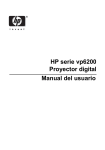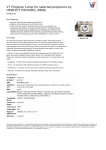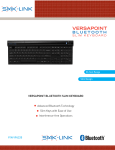Download HP VP6210 DLP PROJECTOR RTL Multimedia Projector
Transcript
HP vp6200 Series Digital Projector User’s Guide Notice © Copyright 2004 Hewlett-Packard Development Company, L.P. The information contained herein is subject to change without notice. The only warranties for HP products and services are set forth in the express warranty statements accompanying such products and services. Nothing herein should be construed as constituting an additional warranty. HP shall not be liable for technical or editorial errors or omissions contained herein. Reproduction, adaptation, or translation without prior written permission is prohibited except as allowed under the copyright laws. Consumer transactions in Australia and the United Kingdom: The above disclaimers and limitations shall not apply to consumer transactions in Australia and the United Kingdom and shall not affect the statutory rights of consumers. Hewlett-Packard Company Digital Projection and Imaging 1000 NE Circle Blvd. Corvallis, OR 97330 Second Edition October 2004 Contents 1. Safety Instructions ................................... 5 2. Introduction .............................................. 7 Projector Features ................................................... 7 Shipping Contents ................................................... 8 Accessories ............................................................. 9 Projector Exterior View ............................................ 9 Front / Upper Side .......................................................................... 9 Rear Side ........................................................................................ 9 Connector Panel ........................................................................... 10 Controls and Functions .......................................... 11 Projector ....................................................................................... 11 Remote Control ............................................................................ 12 Aiming the Remote Control .......................................................... 13 Replacing the Battery in the Remote Control ............................... 13 3. Installation ............................................. 14 Choosing a Location .............................................. 14 Adjusting the Height .............................................. 15 Screen Size ........................................................... 15 4. Connection ............................................ 17 Connecting to a Laptop or Desktop Computer ...... 17 Connecting Component-Video Devices ................. 17 Connecting S-Video Devices ................................. 18 Connecting Composite-Video Devices .................. 18 Connecting to Display Devices .............................. 19 5. Operation ............................................... 20 Startup ................................................................... 20 Shutdown ............................................................... 21 Source Selection ................................................... 21 Keystone Correction .............................................. 22 Auto Sync Adjustment ........................................... 23 Hide the Picture ..................................................... 23 Zoom / Focusing .................................................... 23 Picture Mode ......................................................... 24 Slide Operation ...................................................... 24 Contents 3 Menu Operation ..................................................... 25 Using the Menus .......................................................................... 25 1. Picture Menu ............................................................................ 26 2. Advanced Picture Menu ........................................................... 27 3. Setup Menu .............................................................................. 28 4. Advanced Setup Menu ............................................................. 29 5. Information Menu ..................................................................... 30 6. Maintenance .......................................... 31 Care of the Projector .............................................. 31 Cleaning the Lens ........................................................................ 31 Cleaning the Projector Case ........................................................ 31 Storing the Projector ..................................................................... 31 Transporting the projector ............................................................ 31 Lamp Information ................................................... 32 Warning Messages ....................................................................... 32 Replacing the Lamp ..................................................................... 32 Indicators ............................................................... 34 Power indicator ............................................................................. 34 Lamp indicator .............................................................................. 34 Temperature indicator .................................................................. 34 Updating the firmware ............................................ 34 7. Troubleshooting..................................... 35 8. Specifications ........................................ 36 Projector Specifications ......................................... 36 Timing Chart .......................................................... 37 Supported Timing for PC Input ..................................................... 37 Supported Timing for Component-YPbPr Input ............................ 37 Supported Timing for Composite-Video and S-Video Inputs ........ 37 9. Dimensions............................................ 38 10. Regulation Statements ........................ 39 Safety information .................................................. 39 Safety Precautions ....................................................................... 39 Mercury Safety ............................................................................. 39 Regulatory information ........................................... 39 U.S.A. ........................................................................................... 39 Canada ......................................................................................... 40 Japan ............................................................................................ 40 Korea ............................................................................................ 40 International .................................................................................. 40 4 Contents 1. Safety Instructions Your projector is designed and tested to meet the latest standards for safety of information technology equipment. However, to ensure safe use of this product, it is important that you follow the instructions mentioned in this manual and marked on the product. Warning • • • • • • • • • • • • To prevent shock, do not open the cabinet. There are no user serviceable parts inside. Please read this user’s manual before you operate your projector. Save this user’s manual for future reference. Do not look straight at the projector lens during operation. The intense light beam may damage your eyes. Refer servicing to qualified service personnel. Always open the lens shutter or remove the lens cap when the projector lamp is on. In some countries, the line voltage is NOT stable. This projector is designed to operate safely within a mains voltage between 100 to 240 volts AC, but could fail if power cuts or surges of ±10 volts occur. In areas where the mains voltage may fluctuate or cut out, it is recommended that you connect your projector through a power stabilizer, surge protector or uninterruptible power supply (UPS). The lamp becomes extremely hot during operation. Allow the projector to cool for approximately 45 minutes prior to removing the lamp assembly for replacement. Do not operate lamps beyond the rated lamp life. Excessive operation of lamps beyond the rated life could cause them to break on rare occasions. Never replace the lamp assembly or any electronic components unless the projector is unplugged. Do not place this product on an unstable cart, stand, or table. The product may fall, sustaining serious damage. To reduce the risk of electric shock, do not disassemble this appliance. Take it to a qualified technician when service or repair is required. Incorrect reassembly can cause malfunction of the projector or electric shock when the appliance is subsequently used. This product is capable of displaying inverted images for ceiling mount installation. Use the HP L1704A ceiling mount for mounting the unit and ensure it is securely installed. 1. Safety Instructions 5 • Do not block the ventilation holes. - Do not place this unit on a blanket, bedding or any other soft surface. - Do not cover this unit with a cloth or any other item. - Do not place inflammables near the projector. If the ventilation holes are seriously obstructed, overheating inside the unit may result in damage. • Do not place this unit in any of the following environments. - Space that is poorly ventilated or confined. Allow at least 50 cm clearance from walls and free flow of air around the projector. - Locations where temperatures may become excessively high, such as the inside of a car with all windows rolled up. - Locations where excessive humidity, dust, or cigarette smoke may contaminate optical components, shortening the projector’s life span and darkening the image. - Locations near fire alarms - Locations with an ambient temperature above 35°C / 95°F • • • • 6 Always place the unit on a level, horizontal surface during operation. Do not stand the unit on end vertically. Doing so may cause the unit to fall over, causing injury or resulting in damage to the unit. Do not step on this unit or place any objects upon it. Besides probable physical damage to the unit, doing so may result in accidents and possible injury. Do not place liquids near or on the projector. Liquids spilled into the projector may cause it to fail. If the projector does become wet, disconnect it from the power supply’s wall socket and contact HP to have the projector serviced. 1. Safety Instructions 2. Introduction Projector Features The projector integrates high-performance projection and a user-friendly design to deliver high reliability and ease of use. The projector offers the following features: • • • • • • • • • • Compact and portable unit High quality manual zoom lens One-key auto-adjustment to display the best picture quality Digital keystone correction to correct distorted images Adjustable color balance control for data/video display Ultra-high brightness projection lamp Ability to display 16.7 million colors Switchable normal and Economic modes to reduce the power consumption Powerful AV function HDTV compatibility Note: The apparent brightness of the projected image will vary depending on the ambient lighting conditions and contrast/brightness settings. 2. Introduction 7 Shipping Contents The projector is shipped with the cables required for connection to a PC. Carefully unpack and verify that you have all of the items shown below. If any of these items are missing, please contact your place of purchase. Projector Remote Control Warranty and Support Power cord Quick Setup Guide User’s Guide CD Pull the tab before using the remote control. 8 2. Introduction VGA cable USB Cable Accessories Get more from your presentations with HP projector accessories. You can purchase accessories at www.hp.com or through your projector dealer. • • • • • • HP ceiling mount kit enables you to simply and discreetly install your projector on the ceiling. HP mobile screens with built-in handles are easy to carry and set up anywhere you need them. HP premium remote control allows you to control every aspect of your presentation. HP power cables allow you to connect in any region. HP cables allow you to connect all audio-video equipment. HP replacement lamp brings your projector up to factory-fresh brightness. Projector Exterior View Front / Upper Side Control panel (See page 11 for detailed information.) Focus ring and Zoom ring Ventilation grill Front adjuster button Front adjuster foot Front IR remote sensor Projection lens Lens cap Rear Side Connector panel (See page 10 for more information.) Kensington lock slot Rear adjusters foot 2. Introduction 9 Connector Panel Refer to page 17 for more information on making connections to various equipment. IR remote sensor USB output VGA output Audio input S-Video input VGA input (PC/ YPbPr/ YCbCr) 10 2. Introduction Composite-video input Power cord socket Controls and Functions Projector 6 7 5 4 2 3 1 8 10 9 11 12 1. Hide button (Refer to page 23 for more information.) Hides the display. 2. Source button (Refer to page 21 for more information.) Switches to the next input source. Cycles through VGA, composite video, and S-video inputs. 3. Temperature-warning light (Refer to page 34 for more information.) Turns on when the internal temperature is too high. 4. Lamp-warning light (Refer to page 32 for more information.) Turns on when lamp fails. 5. Keystone buttons (Refer to page 22 for more information.) Adjust the picture to eliminate slanted sides. 6. Focus ring Adjusts the focus of the picture. 7. Zoom ring Adjusts the size of the picture. 8. Power button (Refer to pages 20 and 21 for more information.) Turns the projector on or off. 9. Menu button and directional arrows (Refer to page 25 for more information.) Change projector settings using the on-screen menu. 10. Auto sync button (Refer to page 23 for more information.) Resynchronizes the projector to a PC input signal. 11. Picture mode button (Refer to page 24 for more information.) Adjusts the picture so it is optimized for different types of inputs. 12. Keystone buttons (Refer to page 22 for more information.) Adjust the picture to eliminate slanted sides. 2. Introduction 11 Remote Control 5 4 6 7 3 8 2 9 1 1. 2. 3. 4. 5. 6. 7. 8. 9. 12 Keystone button (Refer to page 22 for more information.) Adjust the picture to eliminate slanted sides. Menu button and directional arrows (Refer to page 25 for more information.) Change projector settings using the on-screen menu. Keystone button (Refer to page 22 for more information.) Adjust the picture to eliminate slanted sides. Page-up and page-down buttons (Refer to page 24 for more information.) Scroll up and down through pages on a connected PC. Hide button (Refer to page 23 for more information.) Hides the display. Picture mode button (Refer to page 24 for more information.) Adjusts the picture so it is optimized for different types of inputs. Auto sync button (Refer to page 23 for more information.) Resynchronizes the projector to a PC input signal. Source button (Refer to page 21 for more information.) Switches to the next input source. Cycles through VGA, composite video, and S-video inputs. Power button (Refer to pages 20 and 21 for more information.) Turns the projector on or off. 2. Introduction Aiming the Remote Control Infrared (IR) remote control sensors are located on the front and the back of the projector. The remote control must be held at an angle within 30 degrees of the projection screen or the projector’s IR remote control sensors to function correctly. The distance between the remote control and the sensors should not exceed 6 meters (19.5 feet). 6m Notes on Remote Control Operation: Make sure that there are no obstacles between the remote control and the IR sensors on the projector that might obstruct the infra-red beam. Replacing the Battery in the Remote Control 1. 2. Using a ballpoint pen, push and hold the battery latch toward the center, then pull out the battery holder. Remove the old battery from the battery holder. 1 2 3. 4. Insert the new battery in the holder. Push the holder into the remote control. Avoid excessive heat and humidity. There may be danger of an explosion if the battery is incorrectly replaced. Replace only with the same or equivalent type recommended by the manufacturer. Dispose of the used battery according to the manufacturer’s instructions. 2. Introduction 13 3. Installation Choosing a Location Your projector is designed to be installed in the four installation configurations shown here. Your room layout or personal preference will dictate which installation configuration you use. I. Table front II. Ceiling front III. Table rear IV. Ceiling rear For further information on the four configurations, please refer to page 29. If you place the projector above or below the screen, you have to tilt it down or up to center the image on the screen, in these situations image distortion will occur. Use the Keystone function to correct the distortion. See page 22 for keystone correction. 14 3. Installation Adjusting the Height The projector is equipped with 1 quick-release adjuster foot and 2 rear adjuster feet. These adjusters change the image height and projection angle. To adjust the projector, 1. 2. Lift the projector up and press the adjuster button to release the adjuster. The adjuster will drop into position and be locked. It can lift the projector by up to 15 degrees. Screw the rear adjuster feet to fine tune the horizontal angle. Press the adjuster button again to retract the foot. If the screen and the projector are not perpendicular to each other, the projected image becomes trapezoidal. To correct this situation, adjust the value of Keystone in the Picture menu, on the projector control panel or on the remote control. Screen Size Place the projector at the required distance from the screen according to the required picture size (see the table on the next page). Max imum z oom Mini mu m z oom Pr c oje ce tan s i nd tio Focus ring Min. zoom Max. zoom 3. Installation 15 Screen size chart (4:3 aspect ratio) Distance from screen feet 4 6 8 10 12 14 16 18 20 22 24 26 28 30 32 inch 48 72 96 120 144 168 192 216 240 264 288 312 336 360 384 Diagonal ment Minimum zoom Maximum zoom Distance Diagonal measurement from screen Minimum Maximum zoom zoom feet 2.49 3.73 4.98 6.22 7.47 8.71 9.96 11.20 12.45 13.69 14.94 16.18 17.42 18.67 19.91 feet 3.05 4.57 6.10 7.62 9.14 10.67 12.19 13.72 15.24 16.76 18.29 19.81 21.34 22.86 24.38 meter 1 1.5 2 2.5 3 3.5 4 4.5 5 5.5 6 6.5 7 7.5 8 inch 29.9 44.8 59.7 74.7 89.6 104.5 119.5 134.4 149.4 164.3 179.2 194.2 209.1 224.0 239.0 measure- inch 36.6 54.9 73.2 91.4 109.7 128.0 146.3 164.6 182.9 201.2 219.5 237.7 256.0 274.3 292.6 cm 100 150 200 250 300 350 400 450 500 550 600 650 700 750 800 meter 0.62 0.93 1.24 1.56 1.87 2.18 2.49 2.80 3.11 3.42 3.73 4.04 4.36 4.67 4.98 cm meter cm 62.2 0.76 76.2 93.3 1.14 114.3 124.5 1.52 152.4 155.6 1.91 190.5 186.7 2.29 228.6 217.8 2.67 266.7 248.9 3.05 304.8 280.0 3.43 342.9 311.2 3.81 381.0 342.3 4.19 419.1 373.4 4.57 457.2 404.5 4.95 495.3 435.6 5.33 533.4 466.7 5.72 571.5 497.8 6.10 609.6 Screen size chart (16:9 aspect ratio) Distance from screen feet 4 6 8 10 12 14 16 18 20 22 24 26 28 30 32 inch 48 72 96 120 144 168 192 216 240 264 288 312 336 360 384 Diagonal ment Minimum zoom Maximum zoom Distance Diagonal measurement from screen Minimum Maximum zoom zoom feet 2.29 3.44 4.59 5.74 6.88 8.03 9.18 10.32 11.47 12.62 13.77 14.91 16.06 17.21 18.35 feet 2.80 4.20 5.60 7.00 8.40 9.80 11.20 12.60 14.00 15.39 16.79 18.19 19.59 20.99 22.39 meter 1 1.5 2 2.5 3 3.5 4 4.5 5 5.5 6 6.5 7 7.5 8 inch 27.5 41.3 55.1 68.8 82.6 96.4 110.1 123.9 137.7 151.4 165.2 179.0 192.7 206.5 220.3 measure- inch 33.6 50.4 67.2 84.0 100.8 117.6 134.4 151.2 167.9 184.7 201.5 218.3 235.1 251.9 268.7 cm 100 150 200 250 300 350 400 450 500 550 600 650 700 750 800 meter 0.57 0.86 1.15 1.43 1.72 2.01 2.29 2.58 2.87 3.15 3.44 3.37 4.02 4.30 4.59 cm meter cm 57.4 0.70 70.0 86.0 1.05 105.0 114.7 1.40 140.0 143.4 1.75 179.4 172.1 2.10 209.9 200.8 2.45 244.9 229.4 2.80 279.9 258.1 3.15 314.9 286.8 3.50 349.9 315.5 3.85 384.9 344.1 4.20 419.9 372.8 4.55 454.9 401.5 4.90 489.8 430.2 5.25 524.8 458.9 5.60 559.8 There is 3% ~ 5% tolerance among these numbers due to optical component variations. 16 3. Installation 4. Connection When connecting a signal source to the projector, be sure to: 1. 2. 3. Turn all equipment off before making any connections. Use the correct signal cables for each source. Ensure the cables are firmly inserted. In the connections shown below, only certain cables are included with the projector (see page 8). Other cables are available from HP or from electronics stores. Connecting to a Laptop or Desktop Computer USB cable Audio cable VGA cable Connecting Component-Video Devices Audio cable Component Video Cable AV equipment YPbPr VGA The projector is capable of displaying various High Definition TV display modes. Some of these sources are: • Digital-VHS (D-VHS) player • DVD player • Satellite Dish HDTV receiver • Digital TV tuners Most of these sources will provide an analog component video output, a standard VGA output, or a YPbPr (default) format. The projector is capable of accepting HDTV data through a Component Video connector. Use a Component Video cable (an optional accessory) to display these images. The following standards are supported in the HDTV function: • • • 480i 576i 720p (50/ 60 Hz) • • • 480p 576p 1080i (50/ 60 Hz) 4. Connection 17 Connecting S-Video Devices Audio cable S-Video cable Connecting Composite-Video Devices Audio cable Composite -video cable If the selected video image is not displayed after the projector is turned on and the correct video source has been selected, check that the video source is turned on and operating correctly. Also check that the signal cables have been connected correctly. 18 4. Connection Connecting to Display Devices If you want to monitor your presentation close-up on a monitor as well as on the screen, you can connect the VGA signal output port on the projector to an external monitor with a VGA cable. VGA cable 4. Connection 19 5. Operation Startup 1. 2. Switch all of the connected equipment on. Plug the power cord into the projector and into a wall socket. 3. 4. Turn on the wall socket switch (where fitted). Press Power on the remote control or projector to start the unit. The Power button flashes during warm up, then turns on solid. 5. The projector searches the input ports for an input signal. A message on the screen shows the ports being searched. You can also press source on the projector or remote control to select your desired input signal. For more information, please refer to page 21. If the frequency or resolution of the input signal exceeds the projector’s operating range, you will see the message “Out of Range” displayed on a blank screen. 20 5. Operation Shutdown 1. Press the Power button on the projector or remote control. The Power button flashes and the lamp shuts down, the fans continue to run for approximately 2 minutes to cool down the projector. To protect the lamp, the projector will not respond to any commands during the cooling process. 2. Disconnect the power cord from the wall socket. Do not unplug the power cord before the projector shutdown sequence is complete or during the 2-minute cooling down process. If the projector is not properly shut down, and you attempt to restart it soon after, the fans may run for a few minutes to cool down. Press Power again to start the projector after the fans stop. Source Selection To sequentially select input sources, press source on the projector control panel or the remote control. It may take you a few seconds when the projector is searching for input signals. The selected source will be displayed at the bottom right of the screen for 3 seconds. For a quick search, you can also press the key repeatedly until your desired signal is displayed. 5. Operation 21 Keystone Correction Keystoning refers to the situation where the projected image is noticeably wider at either the top or bottom. It occurs when the projector is not perpendicular to the screen. To correct this, besides adjusting the height of the projector, you will need to manually correct it following one of these steps. • Press the keystone up or keystone down button on the remote control or remote control to display the status bar labelled Keystone, then press the keystone up button to correct keystoning at the top of the image or press the down button to correct keystoning at the bottom of the image. • Press the menu button on the projector or remote control. Go to Picture > Keystone and adjust the values by pressing the button. 22 keystone 5. Operation left or right 0 -6 0 +6 Auto Sync Adjustment In some situations when showing a PC display, the picture may be cut off at the edges. To correct this, press auto sync on the the projector or remote control. Within 3 seconds, the projector will re-adjust the values of Frequency and Tracking to provide the best picture quality. The current source information will be displayed at the bottom right of the screen for 3 seconds. The screen will be blank while auto sync is functioning. Hide the Picture In order to draw the audience’s full attention to the presenter, you can use hide to hide the screen image. Press hide again to restore the image. When this function is activated with an audio signal connected, the background sound still can be heard. If the picture remains hidden for a long time, the projector automatically shuts down. To set the delay, press menu and go to Advanced Setup > Power timeout. Zoom / Focusing Adjust the projected image to your desired size using the zoom ring. Then focus the image by rotating the focus ring. Refer to the screen size tables on page 16. Focus ring Zoom out Zoom in 5. Operation 23 Picture Mode Press the picture mode button on the projector or remote control to select a operation mode that suits your need. There are several operation modes available for different types of signals. PC Signal Input Graphics Vivid Video Economy YPbPr / S-Video / Composite-Video Signal Input Gaming Video Cinema Economy Refer to page 26 for more information. Slide Operation You can operate your PowerPoint presentation moving forwards and backwards by pressing Page Up and Page Down on the remote control. You must connect the projector to your PC or notebook with a USB cable prior to using this function. 24 5. Operation Menu Operation Using the Menus The projector is equipped with on-screen menus for making various adjustments and settings. The following example describes the adjustment of the keystone setting. 1. 2. Press menu on the projector or remote control to open the onscreen menu. 4. Press the left or right button on the projector or remote control to 5. select the 3. Picture menu. Adjust keystone values by pressing the left or right button on the projector or remote control. Press the menu button on the projector or remote control to leave and save the setting. Press the up or down button on the projector or remote control to select Keystone. 5. Operation 25 1. Picture Menu Some picture adjustments are available only when certain input ports are in use. Unavailable adjustments are not shown on the screen. FUNCTION DESCRIPTION Picture mode is provided so you can optimize your projector image set-up to suit your program type. PC Signal Input 1. 2. 3. 4. Picture mode Graphics Mode: Is designed for presentations. The brightness is emphasized in this mode. Vivid Mode: Is perfect for playing games. The color saturation and brightness are well-balanced. Video Mode: Is suitable for cinematic enjoyment displaying images in their natural color. Economy Mode: Use this mode to reduce system noise and reduce power consumption by 20%. The lamp life is also extended with lower light output. YPbPr/ S-Video/ Composite-Video Signal Input 1. Keystone Gaming Mode: Is suitable for playing video games in a bright living room. 2. Video Mode: With a higher color temperature, it is suitable for enjoying TV movies. 3. Cinema Mode: With a lower color temperature, it is suitable for enjoying cinematic movies. 4. Economy Mode: Use this mode to reduce system noise and reduce power consumption by 20%. The lamp life is also extended with lower light output. Corrects any keystoning of the image. Refer to page 22 for more information. Adjusts the brightness of the image. The higher the value, the brighter the image. And lower the setting, darker the image. Adjust this control so the black areas of the image appear black but detail in the dark areas is visible. Brightness -30 50 +70 Adjusts the degree of difference between dark and light in the image. The higher the value, the greater the contrast. Contrast -30 26 5. Operation 50 +70 Saturation Increases or decreases the color intensity of the image. Tint Adjusts the color tones of the image. The higher the value, the more reddish the image becomes. The lower the value, the more greenish the image becomes. 2. Advanced Picture Menu Some picture adjustments are available only when certain input ports are in use. Unavailable adjustments are not shown on the screen. FUNCTION Aspect ratio Widescreen input Horizontal offset Vertical offset DESCRIPTION Sets how the picture fits the screen. 1. Fill 2. Best fit Sets whether a widescreen (16:9) input device is in use. 1. No 2. Yes Adjusts the horizontal position of the projected image. -30 +30 -30 +30 Adjusts the vertical position of the projected image. This function allows you to adjust the clock phase to reduce image distortion. Tracking Frequency Adjusts the horizontal width of the image. Sharpness Adjusts the image to make it look sharper or softer. 5. Operation 27 3. Setup Menu FUNCTION DESCRIPTION Turns sound on or off. Mute Not muted Muted Adjusts the volume level. Volume Timeout for menu Sets the length of time the OSD will remain active after your last button press. The range is from 5 to 100 seconds. Reset all settings Returns all settings to the factory preset values. Adjusts the appearance of white. Color temperature 1. Cool: Makes images appear bluish white. 2. Neutral: Maintains normal colorings for white. 3. Warm: Makes images appear reddish white. 28 5. Operation 4. Advanced Setup Menu FUNCTION DESCRIPTION The projector can be installed on a ceiling or behind a screen, or with one or more mirrors. Table front: Select this setting with the projector set on the floor and audience viewing the projected images from the front side of the screen. This is the most common setting. Projector position Ceiling front: Select this setting with the projector suspended from the ceiling and audience viewing the projected images from the front side. Table rear: Select this setting when the projector is placed near the floor and behind the screen. A special rear projection screen is required. Ceiling rear: Select this setting when the projector is suspended from the ceiling and placed behind the screen. A special rear projection screen is required. Power timeout Determines the length of time before the projector will automatically shut down when the picture is hidden. Scan inputs Sets whether the projector searches automatically for input signals. If scanning is on, the projector will scan for input signals in the following order: VGA/YPbPr --> Composite-video --> S-Video until it acquires a signal. If the function is not activated, the projector selects the last input signal. Language Sets the language for the on-screen menus. Password Sets whether a password is required to turn on the projector. Change password Sets or changes the current password. 5. Operation 29 5. Information Menu This menu shows you the current operating status of the projector. 30 5. Operation 6. Maintenance Care of the Projector Your projector needs little maintenance. Keep it clean for best performance. Never remove any parts of the projector except the lamp. Contact your dealer if other parts needs replacing. Cleaning the Lens Clean the lens whenever you notice dirt or dust on the surface. Use a canister of compressed air to remove dust. If there is dirt or smears, use lens-cleaning paper or moisten a soft cloth with lens cleaner to gently wipe the lens surface. Never rub the lens with abrasive materials. Cleaning the Projector Case Before you clean the case, turn the projector off and unplug the power cord. To remove dirt or dust, wipe the case with a soft, dry, lint-free cloth. To remove stubborn dirt or stains, moisten a soft cloth with water and a neutral detergent. Then wipe the case. Never use wax, alcohol, benzene, thinner or other chemical detergents. These can damage the case. Storing the Projector If you need to store the projector for an extended time, please follow the instructions below. Make sure the temperature and humidity of the storage area are within the recommended range for the projector. Please refer to page 36 in the manual. Retract the adjuster feet. Remove the batteries from the remote control. Pack the projector in its original packing or equivalent. Transporting the projector It is recommended that you ship the projector with its original packing or equivalent. 6. Maintenance 31 Lamp Information Warning Messages When the Lamp indicator lights up red or a message appears suggesting it is time to replace the lamp, please install a new lamp or consult your dealer. An old lamp may cause a malfunction in the projector and in some instances the lamp may break. For more detailed information on the lamp indicator, please refer to page 34. The Lamp indicator light and Temperature warning light will light up if the lamp becomes too hot. Turn the power off and let the projector cool for 45 minutes. If the Lamp or Temp indicator still lights up after turning the power back on, please contact your dealer. The following Lamp warning messages will remind you to change the lamp. Message Lamp is getting old. Buy a spare lamp. End of lamp life Install a new lamp. Then hold [V] to reset lamp hours. Status The lamp has been in operation for a long time, and you should have a spare lamp available. For optimal performance, install a new lamp. The lamp has reached the end of its life, and the projector will not operate normally until you change the lamp. Replacing the Lamp To reduce the risk of electrical shock, always turn the projector off and disconnect the power cord before changing the lamp. To reduce the risk of severe burns, allow the projector to cool for at least 45 minutes before replacing the lamp. To reduce the risk of injuries to fingers and damage to internal components, use caution when removing lamp glass that has shattered into sharp pieces. To reduce the risk of injuries to fingers and/or compromising image quality by touching the lens, do not touch the empty lamp compartment when the lamp is removed. The lamp contains a small amount of mercury. If the lamp breaks, adequately ventilate the area where the breakage occurred. Disposal of this lamp might be regulated due to environmental considerations. For disposal or recycling information, contact your local authorities or the Electronic Industries Alliance (http://www.eiae.org). 1. 2. 3. 32 Turn off the projector. After the power button stops flashing, unplug the power cord from the wall socket. Turn the projector over. Then loosen the screws and remove the lamp cover. If the lamp is hot, avoid burns by waiting for 45 minutes until the lamp has cooled. 6. Maintenance 4. Loosen the screw that holds the lamp to the projector. If the screw is not loosened completely, they could injure your fingers. It is strongly recommended that you use a magnetic-head screwdriver. 5. Slide the latch to release the lamp. 6. Lift the handle so that it stands up. Use the handle to slowly pull the lamp out of the projector. Pulling it too quickly may cause the lamp to break and scatter broken glass in the projector. Do not place the lamp in locations where water might splash on it, children can reach it, or near flammable materials. Do not insert your hands into the projector after the lamp is removed. If you touch the optical components inside, it could cause color unevenness and distortion of the projected images. 7. Insert a new lamp. Make sure the handle is fully locked and tighten the screw firmly. Slide the latch so it holds the lamp. If the screw is loose, it could result in a malfunction. Do not over tighten the screw. 8. Re-install the lamp cover and tighten the screw. Do not turn the power on with the lamp cover removed. 9. Plug in the projector and turn it on. 10. Unplug all input cables. 11. Reset the lamp counter. Do not reset if the lamp is not replaced as this could cause damage. i. Press and hold the up button on the projector for 5 seconds to display the reset message. ii. Press auto sync on the projector or on the remote control to reset the lamp hours to “0”. iii. Wait about 5 seconds to let the message disappear. 6. Maintenance 33 Indicators Power indicator Off The projector is off. Flashing The projector is warming up or cooling down. On The projector is on and operating normally. Lamp indicator Off The projector is operating normally. On The lamp is bad or has reached the end of its life. Temperature indicator Off The projector is operating normally. Flashing The fans are not working, and the projector will shut down. Contact HP about repairs. On The internal temperature is too high, and the projector will shut down. Allow the projector to cool down. If this continues, contact HP about repairs. Updating the firmware HP may periodically release updated versions of the projector firmware to enhance the projector performance. The projector firmware version is shown in the onscreen menu in the Information menu. Check for updated versions at http:// www.hp.com/go/proj_firmware. 34 1. On a computer with a USB port, go to the HP projector upgrade website (see introduction for this section) and download the latest file intended for a USB upgrade. 2. Connect the USB cable between the USB port on the projector and the USB port on the computer. 3. On the computer, run the file you downloaded by double-clicking the file. Follow the on-screen instructions. 6. Maintenance 7. Troubleshooting The projector does not turn on. Cause Remedy There is no power from the power cord. Plug the power cord into the AC inlet on the projector, and plug the power cord into the power outlet. If the power outlet has a switch, make sure that it is switched on. Attempting to turn the projector on again during the cooling process. Wait until the cooling down process has completed. No picture Cause Remedy The video source is not turned on. Turn the video source on. The projector is not correctly connected to the input source device. Check that the signal cable is connected correctly. The input signal has not been correctly selected. Select the correct input signal with the source button on the projector or remote control. The lens cap is still attached to the lens. Remove the lens cap. Blurred image Cause Remedy The projection lens is not correctly focused. Adjust the focus of the lens using the focus ring. The projector and the screen are not aligned properly. Adjust the projection angle and direction as well as the height of the unit if necessary. The lens cap is still attached to the lens Remove the lens cap. Remote control does not work. Cause Remedy The battery is out of power. Replace the battery in the remote control with a new one. There is an obstacle between the remote control and the projector. Remove the obstacle. You are too far away from the projector. Stand within 6 meters (19.5 feet) of the projector. To use the page up and page down functions, For a PC connection, the USB cable is connect the USB cable between the PC and not connected. projector. 7. Troubleshooting 35 8. Specifications Projector Specifications All specifications are subject to change without notice. General Product name Model name Digital Projector vp6220 (XGA) vp6210 (SVGA) Optical Display system Lens F/Number 1-CHIP DMD vp6220 F=2.4 to 2.6, f= 24.0 to 29.1 mm Lamp vp6210 F=2.4 to 2.6, f= 18.6 to 22.7 mm 200W lamp Electrical Power supply Power consumption AC100 ~ 240V, 3.5A, 50/60 Hz (Automatic) 265W (Max) Mechanical Dimensions Weight 311 mm (W) x 90 mm (H) x 215 mm (D) 2.8 Kg (6.1 lbs) Input terminal Computer input VGA input Video signal input S-video Composite-video HDTV signal input Audio signal input Audio in D-sub 15-pin (female) Mini DIN 4-pin port x1 RCA jack x1 D-sub to YPbPr RCA jack x3, through VGA input Mini jack stereo port Output USB mouse connector Speaker A/B series x1 1 watt x 1 Environment Operating Temperature Humidity Altitude Storage Temperature Humidity Altitude 36 8. Specifications 10 to 35 °C (50 to 95 °F) 80% RH max, non-condensing up to 3,000 m (10,000 ft), up to 25 °C (77 °F) -25 to 55 °C (-4 to 131 °F) 80% RH max, non-condensing up to 12,000 m (40,000 ft) Timing Chart Supported Timing for PC Input Resolution 720x400 640x480 800x600 1024x768 1280x1024 Horizontal Frequency (kHz) Vertical Frequency (Hz) Pixel Frequency (MHz) Mode 37.927 31.469 37.861 37.500 43.269 37.879 48.077 46.875 53.674 48.363 56.476 60.023 68.667 63.981 85.039 59.940 72.809 75.000 85.008 60.317 72.188 75.000 85.061 60.004 70.069 75.029 84.997 60.020 35.500 25.175 31.500 31.500 36.000 40.000 50.000 49.500 56.250 65.000 75.000 78.750 94.500 108.000 720x400_85 VGA_60 VGA_72 VGA_75 VGA_85 SVGA_60 SVGA_72 SVGA_75 SVGA_85 XGA_60 XGA_70 XGA_75 XGA_85 SXGA3_60 Supported Timing for Component-YPbPr Input Signal Format Horizontal Frequency (kHz) Vertical Frequency (Hz) 480i(525i)@60Hz 480p(525p)@60Hz 576i(625i)@50Hz 576p(625p)@50Hz 720p(750p)@60Hz 720p(750p)@50Hz 1080i(1125i)@60Hz 1080i(1125i)@50Hz 15.73 31.47 15.63 31.25 45.00 37.50 33.75 28.13 59.94 59.94 50.00 50.00 60.00 50.00 60.00 50.00 Supported Timing for Composite-Video and S-Video Inputs Video mode Horizontal Frequency (kHz) Vertical Frequency (Hz) Color subcarrier Frequency (MHz) NTSC PAL SECAM PAL-M PAL-N PAL-60 NTSC4.43 15.73 15.63 15.63 15.73 15.63 15.73 15.73 60 50 50 60 50 60 60 3.58 4.43 4.25 or 4.41 3.58 3.58 4.43 4.43 8. Specifications 37 9. Dimensions 90 215 311 Unit: mm 38 9. Dimensions 10. Regulation Statements Safety information Safety Precautions • • • • • Prevent eye injury. Do not look into the projector's lens when the lamp is on. Do not point any laser light at anyone's eyes. Prevent electrical shock. Do not expose the projector or rain or moisture. Do not open the projector except as instructed by the manual. Allow the projector to cool before removing the lamp cover and touching internal components, as instructed by the manual. Keep paper, plastic, and combustible material at least 0.5 meter (2 feet) away from the projector lens and exhaust vents. Use only an approved power cord rated for the voltage and current marked on the product label. Do not overload any outlet or extension cord. Mercury Safety Warning: This digital projector lamp contains a small amount of mercury. If the lamp breaks, adequately ventilate the area where the breakage occurred. Disposal of this lamp may be regulated due to environmental considerations. For disposal or recycling information, please contact your local authorities or the Electronic Industries Alliance (www.eiae.org). Regulatory information This section presents information that shows how your digital projector complies with regulations in certain regions. Any modifications to your digital projector not expressly approved by Hewlett-Packard could void the authority to operate the digital projector in these regions. U.S.A. This digital projector has been tested and found to comply with the limits for a Class B digital device, pursuant to Part 15 of the FCC Rules. These limits are designed to provide reasonable protection against harmful interference in a residential installation. This digital projector generates, uses, and can radiate radio frequency energy. If not installed and used in accordance with the instructions, it may cause harmful interference to radio communications. However, there is no guarantee that interference will not occur in a particular installation. If this digital projector does cause harmful interference to radio or television reception (which can be determined by unplugging the unit), try the following: • Reorienting or relocating the receiving antenna. • Relocating the digital projector with respect to the receiver. • Connecting the digital projector's power cord to another power outlet. Connections to Peripheral Devices. To maintain compliance with FCC Rules and Regulations, use properly shielded cables with this device. 10. Regulation Statements 39 For more information, consult your dealer, an experienced radio/television technician, or the following booklet, prepared by the Federal Communications Commission: How to Identify and Resolve Radio-TV Interference Problems. This booklet is available from the U.S. Government Printing Office, Washington, DC 20402, Stock Number 004-000-00345-4. At the first printing of this manual, the telephone number was (202) 512-1800. Canada This Class B digital apparatus complies with Canadian ICES-003. Japan Korea International NOTE: For regulatory identification purposes, your product is assigned a Regulatory Model number. The Regulatory Model number for your product is listed in the declaration below. This regulatory number is different from the marketing name and product number. 40 10. Regulation Statements DECLARATION OF CONFORMITY According to ISO/IEC Guide 22 and EN 45014 Manufacturer's Name: Manufacturer's Address: Hewlett Packard Company Hewlett Packard Company Digital Projection & Imaging 1000 NE Circle Blvd. Corvallis, OR 97330-4239 Declares, that the product(s): Product Name: Digital Projector Model Number(s): vp6210, vp6220 Regulatory Model: CRVSB-04CI Conforms to the following product specifications: Safety: IEC 60950:1999 / EN 60950:2000 GB4943-1995 EMC: EN 55022: 1998 +A1. +A2 Class B [1] CISPR 24:1997 / EN 55024: 1998 +A1, +A2 EN 61000-3-2:2000 EN 61000-3-3:A1:2001 GB9254-1998 FCC Title 47 CFR, Part 15 Class B/ANSI C63.4:1992 AS/NZS 3548:1995 Rules and Regulations of Class B Supplementary information: The product herewith complies with the requirements of following Directives and carries the CE marking accordingly: -Low Voltage Directive: 73/23/EEC -EMC Directive: 89/336/EEC [1] The product was tested in a typical configuration with Hewlett Packard Personal Computer peripherals. This device complies with Part 15 of the FCC Rules. Operation is subject to the following two conditions: (1) this device may not cause harmful interference, and (2) this device must accept any interference received, including interference that may cause undesired operation. Corvallis, Oregon, October 1, 2004 Steve Brown, General Manager European Contact for regulatory topics only: Hewlett Packard GmbH, HQ-TRE, Herrenberger Strase 140, 71034 Boeblingen, Germany. (FAX:+49-7031143143). USA Contact: Hewlett Packard Co., Corporate Product Regulations Manager, 3000 Hanover Street, Palo Alto, CA 94304. Phone: (650) 857-1501. 10. Regulation Statements 41



















































